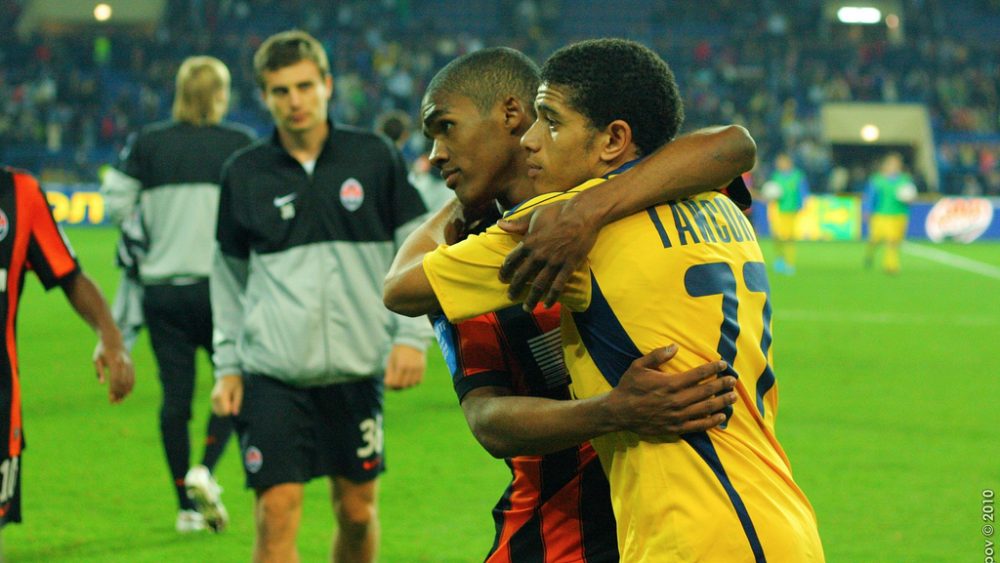Scouting-Report: Douglas Costa
The career of Douglas Costa has been a pretty straightforward affair so far. He took his first footballing steps at a club named EC Novo Hamburgo before joining Gremio, one of the biggest and most famous clubs of Southern Brazil, at the age of 11.
Costa made his first team debut at the age of 18, where he immediately was a part of the starting lineup and scored his first goal after 33 minutes. The following year, 2009 to be precise, saw his breakthrough as a promising talent. Regular appearances for Gremio were coupled with being a part of the Brazilian U20 national team, both at the South American championships that Brazil won and the U20 World Cup where they lost the final in a shootout. Costa, a substitute, converted his penalty with authority.
Such a development could no longer keep him hidden from the eyes of the international scouting departments. In January 2010, Douglas Costa joined the Ukrainian champions from Donezk, a very popular destination for Brazilians looking to move to Europe. Being surrounded by compatriots, he didn’t suffer much from a culture shock. It only took him three matches to score his first goal in the Ukraine and in the next ten matches he added another four to his goal count, leading to Costa averaging a goal every 117 minutes in his first (half) season in Europe.
From then on, the left-footed winger has been an integral part of the starting lineup. Year after year, he scores about 5 goals per campaign with volatile assist numbers and a recent upwards trend. Furthermore, Douglas Costa offers plenty of international experience, having appeared in 34 Champions League matches where he’s scored 6 times already.
Since late 2014, Costa is also a part of the Brazilian national team. Following five appearances in friendlies, he was chosen to represent his country at the ongoing Copa America where he scored his first international goal in added time against Peru.
His strengths and weaknesses
Douglas Costa’s biggest strength is undoubtably his dribbling ability. He solves every situation in typically Brazilian fashion, using his creativity to get past defenders with unexpected moves. That makes him very difficult to defend in one-on-ones, it’s not easy to separate him from the ball.
Costa also isn’t a purely vertical player, he’s always willing to use half spaces and diagonal runs to his advantage. He operates all over the pitch and often enters unexpected spaces to get away from his opponent. In fact, he even uses diagonal runs towards the center when running down the left flank, a trait that’s not at all typical for left-footed players.
His pace is at the very least above average, another thing helping him when dribbling. Passes are played with lots of power but not too much, an underrated ability in the world of football. Using his weaker foot isn’t an issue for Costa, either. He shouldn’t have any problems with the high-speed football of the Bundesliga, as his awareness and passing don’t suffer from a high pace.
That being said, there are lots of question marks surrounding him. The emotions that he proved against Bayern aside, there are some deserved doubts about his production on the pitch. Most obvious is his extreme tendency to go for the dribble. Costa often gets stuck with the ball, as his weak dribbling accuracy of 48% in the Champions League proves.
Such a tendency of course also leads to unnecessary turnovers. Instead of playing a pass to the unmarked teammates, the 24-year-old often starts another dribble. It’s doubtful if a coach like Guardiola could get him to stop doing that, as Costa’s football IQ is somewhat questionable, causing the ridiculously low number of 0.5 key passes per CL match.
His role in the Bayern system
To sum up, it can be said that Douglas Costa would certainly be the cause for lots of entertainment, it wouldn’t take him long to become a fan favorite among kids. It’s very uncertain just how well he could accept and integrate into the Bavarian passing game. In theory, Costa has all the tools to improve a team like Bayern at the very top, the question is whether his football IQ is enough to do that or if he’s doomed to forever be nothing but a glorified street player.
Another question is what his position at Bayern would be. Costa’s main position is the right flank where he acts as an inverted winger, similar to Robben. However, as a player type he seems more suited for the Ribery role, partially because he lacks goal scorer qualities, despite a very powerful shot. This means that, if you were to use Costa in the Ribery role, you’d do without the typically Bavarian element of an inverted wing. Or, if you were to have him replace Arjen Robben in the medium term, you’d need more of a goal threat on the left flank.









